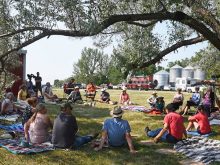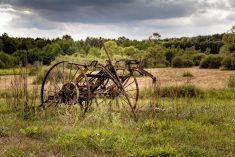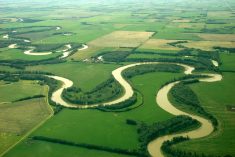This article was first published in September 2021 as part of a collection of stories and media exploring truth and reconciliation. View it in its original form here.
Glacier FarmMedia—More than a century after its creation, there is no visible sign remaining of the File Hills Farm Colony in southern Saskatchewan. But the painful memories of an experiment that epitomized the culture of assimilation permeating that era’s attitudes towards Canada’s Indigenous peoples still live in the collective memories of residential school survivors. Likewise for some of the racist attitudes and policies that still exist today.
Rather allowing that piece of history to define the story of Indigenous agriculture, a new generation – this time under Indigenous leadership – is working to create a different future for First Nations in the sector.
Thomas Benjoe, president and CEO of FHQ Developments, points to the File Hills Colony as an example of how projects touted at the time as progressive actually held Indigenous agriculture back.
He is leading efforts by First Nations in the File Hills area to carve out a new legacy for Indigenous people in agriculture. FHQ Developments is operated by the 11 First Nations (including Peepeekisis) belonging to the File Hills Qu’Appelle Tribal Council.
Painful legacy
As the the 19th century bled into the 20th, the region’s Indian agent William Morris Graham devised the colony as a way to prevent Indigenous residential school graduates from reverting to traditional lifestyles once they completed their time at these schools.
Specially chosen graduates of residential schools were given an opportunity to farm on prime agriculture land belonging to the Peepeekisis Cree Nation, even though many of them were not members of that nation.
Members of Peepeekisis were displaced to a smaller area, while select graduates were encouraged to live like colonial homesteaders – and afforded many luxuries their peers didn’t have.
The Canadian government held out the colony as an example of how Indigenous populations could be assimilated but disregarded how it was preventing other First Nations from acquiring land, machinery and capital needed for long-term success.
Read Also

Workers at Maple Leaf’s Lagimodiere plant in Winnipeg give overwhelming strike mandate
Workers at the Maple Leaf Consumer Foods plant on Lagimodiere Boulevard in Winnipeg, voted 98 per cent in favour of a strike mandate on Nov. 15.
Indigenous farmers were at the mercy of Indian Agents who could limit what was grown, control their access to equipment and what lands they could access.
The File Hills Colony eventually became riddled with controversy due to disputes over what amounted to illegal redistribution of reserve lands and suspicion that the government agents overseeing the operation were making off with some of the profits.
Legal action was filed in the 1950s to have the colony removed.
Earlier this year, the federal government provided $150 million in total compensation to Peepeekisis First Nation, with an option to acquire 18,720 acres of land.
“In creating and implementing the Colony Scheme, Canada breached its fiduciary duty to the Nation by failing to protect the Nation’s interest in the land and not providing any compensation to the Nation,” says a government release. “The historic and ongoing harm that the Colony Scheme caused to the Peepeekisis Nation created community divisions and animosity between families and members. The legacy of the Colony Scheme continues to impact the Nation to this day.”
Now considered to be an example of colonial oppression, the File Hills Colony colony forced a Euro-centric, agrarian way of life upon Indigenous communities.
“All of these things, all of these policies, have significantly worked against Indigenous communities to be able to actively participate and create that long history of what we need in the ag industry,” says Benjoe.
Overcoming the past
He sees overcoming that rocky history and re-engaging in agriculture as an important opportunity for First Nations.
“It’s not just from a producer’s perspective, it’s from a tech, manufacturing, and supply chain, where we’re looking at it in a in a much bigger picture of how we can invest in and how we can participate,” he says. “We need to be a part of that leading edge work that is happening all around us, and if we don’t, we’re going to miss out on huge opportunities to participate and create, and be a part of an industry that is both sustainable and renewable.”
While the potential is real, so are the barriers.
Benjoe says the legacy of the File Hills colony and other government policies have led to “barriers for success” and a drop in enthusiasm for agricultural projects among First Nations.
But access to capital is the biggest hurdle holding them back.
“We just can’t compete in an agriculture industry that requires significant capital investment where we can’t get loans,” he said.
“We just don’t have the access to capital that is required to be able to participate at the level that is needed in the ag industry.”
Without access to money for projects on reserve, FHQ Developments is now looking elsewhere: off reserve lands.
“We’re shifting as an organization towards those types of opportunities. Just because, you know, access to capital on reserve is going to be very, very difficult,” he says.
Another way of continuing to look for ways to establish collateral is by finding low-risk ways of getting in the door, says Benjoe.
“Over time, we’re able to demonstrate our capacity and be able to fully participate in much larger contracts and take on more risk with our customers. And so that’s what we need to see in the ag industry,” he says.
Engagement
Through the Saskatchewan Chamber of Commerce, Benjoe is trying to make it easier for companies – in and outside of agriculture – to engage with First Nations through the creation of an Indigenous engagement charter.
“There’s no excuse for any organization, any business in Saskatchewan, to not do something. There’s resources, there’s tools, there’s training, there’s guidance, that’s all there for you now,” he said.
“You have all the levers to be able to allow us access. And if you don’t know how, or if you’re uncomfortable about going down this path, talk to us.”
Agriculture has a blueprint to look to on how best to engage First Nations. Benjoe points to the oil, gas and mining sectors as industries that have set a pretty good foundation of active participation with Indigenous communities.
In those sectors, First Nation-specific procurement policies, engagement and community investment are much more common than what is found in agriculture.
“What I need to be able to see and be able to advocate for is to work with those major ag companies and say, ‘Well, how can we get you thinking about reconciliation? How do we get the organization developing the right policies and making the right investments in unity?” he says.
“That’s where we see the opportunity, and that is why we are pushing forward within the ag industry.”
Champions needed
As Benjoe continues to seek “champions to step up” on the industry side of agriculture, he also expects more action from government.
“The role that government needs to play is around the policy and around the investment, we need them to make capital available, or set up loan loss provisions for us,” he says.
While government programming specific to First Nations and agriculture has increased in recent years, there is still little offered.
What is, such as the five-year, $8.5 million Indigenous Agriculture and Food Systems Initiative launched by the federal government in 2018, is oversubscribed. The program was designed to “support Indigenous communities and entrepreneurs who are ready to launch agriculture and food systems projects and others who want to build their capacity to participate in the Canadian agriculture and agri-food sector.”
Funding per project was capped at $500,000 per year, and in 2021 – three years into the five-year mandate – applications were suspended because the demand was too high.
“Indigenous communities want to participate, it’s just, you’re not putting enough effort and enough dollars towards it, that we can participate at a larger level,” Benjoe says.
“When I think about things that I want to participate in, in the ag tech or manufacturing or supply chain sector, there is a significant amount of capital that we’re going to have to invest.”




















